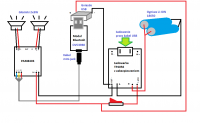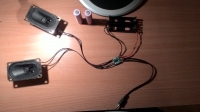Hello,
I recently made a bluetooth speaker on the PAM8403 amplifier. Unfortunately .. there is a problem, namely with "tickling" speakers (I don't know how to describe it otherwise). I thought I was getting a "Mass Loop" so I modified the circuit in all sorts of ways. I have no idea what the reason is, that's why I'm writing here.
Below I present a short video of how it all works after switching on. Unfortunately, I cannot record how the loudspeaker sounds, because it will disconnect my music while recording.
[movie: a37dc16403] https://filmy.elektroda.pl/19_1501749043.mp4 [/ movie: a37dc16403]
I recently made a bluetooth speaker on the PAM8403 amplifier. Unfortunately .. there is a problem, namely with "tickling" speakers (I don't know how to describe it otherwise). I thought I was getting a "Mass Loop" so I modified the circuit in all sorts of ways. I have no idea what the reason is, that's why I'm writing here.
Below I present a short video of how it all works after switching on. Unfortunately, I cannot record how the loudspeaker sounds, because it will disconnect my music while recording.
[movie: a37dc16403] https://filmy.elektroda.pl/19_1501749043.mp4 [/ movie: a37dc16403]




